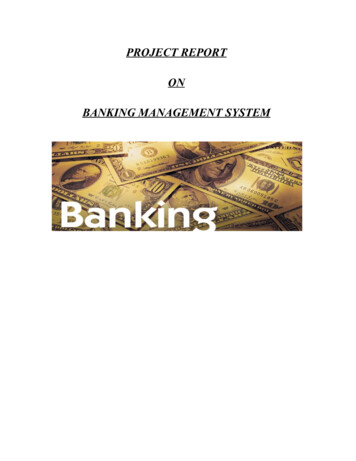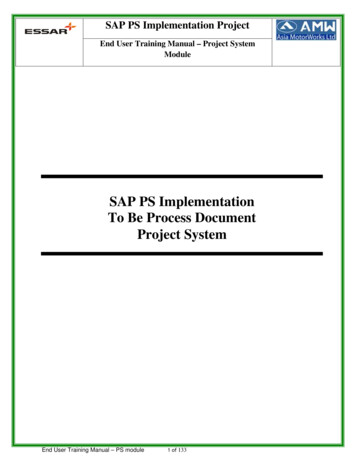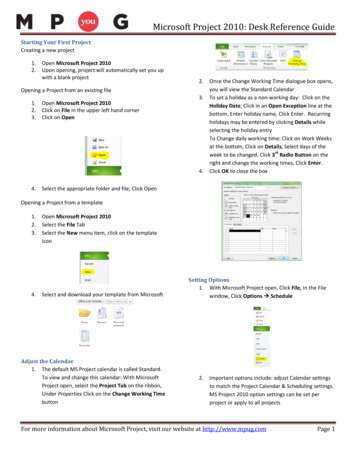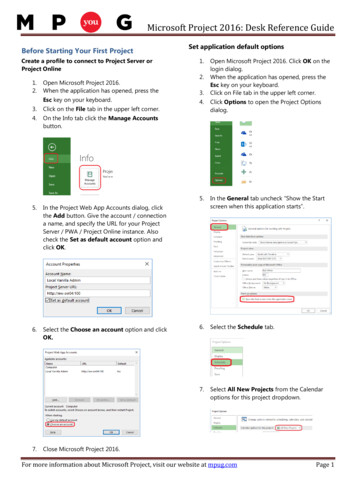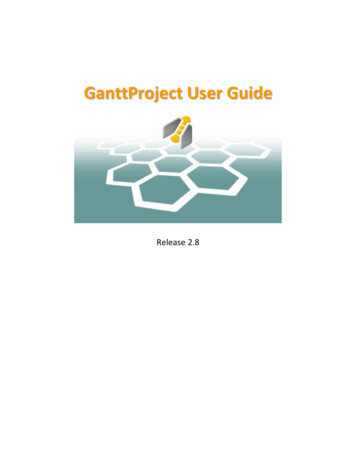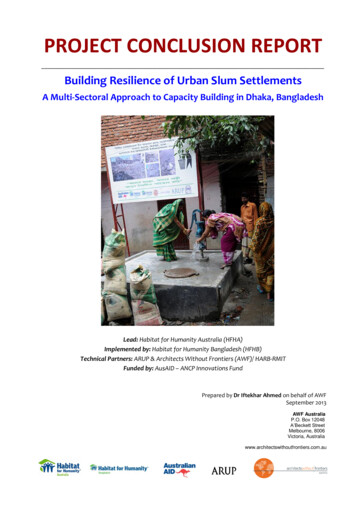
Transcription
PROJECT CONCLUSION REPORTBuilding Resilience of Urban Slum SettlementsA Multi-Sectoral Approach to Capacity Building in Dhaka, BangladeshLead: Habitat for Humanity Australia (HFHA)Implemented by: Habitat for Humanity Bangladesh (HFHB)Technical Partners: ARUP & Architects Without Frontiers (AWF)/ HARB-RMITFunded by: AusAID – ANCP Innovations FundPrepared by Dr Iftekhar Ahmed on behalf of AWFSeptember 2013AWF AustraliaP.O. Box 12048A’Beckett StreetMelbourne, 8006Victoria, Australiawww.architectswithoutfrontiers.com.au
LIST OF ACRONYMSAWFArchitects Without FrontiersCAPCommunity Action PlanningCBPRACommunity Based Participatory Risk AssessmentCDCCommunity Development CommitteeCDPCommunity Development PlanCUPCoalition for the Urban PoorCWCCommunity WaSH CommitteeDFIDDepartment For International Development (UK)HFHHabitat for HumanityHFHAHabitat for Humanity AustraliaHFHBHabitat for Humanity BangladeshIFRCInternational Federation of Red Cross & Red Crescent SocietiesINGOInternational Non-Governmental OrganisationMoUMemorandum of UnderstandingNGONon-Governmental OrganisationPASSAParticipatory Approach for Safe Shelter AwarenessPDAPParticipatory Development Action ProgramSFPShelter for the PoorSRGShelter Reference GroupToTTraining of TrainersUPPRUrban Partnerships for Poverty ReductionWaSHWater, Sanitation and HygieneWVBWorld Vision Bangladesh1
EXECUTIVE SUMMARY This report provides an overview of and presents the key lessons learnt in the AusAID-fundedproject Building Resilience of Urban Slum Settlements: A Multi-Sectoral Approach to CapacityBuilding implemented by Habitat for Humanity Australia (HFHA) in partnership with Habitat forHumanity Bangladesh (HFHB) in Dhaka, Bangladesh. The project was targeted at an urban slumcommunity called Talab Camp in Mirpur, Dhaka, a slum settlement of an ethnic Bihari community. A the beginning of the project, a background document on Factors Pertaining to Building Resilienceof Urban Slum Settlements in Dhaka, Bangladesh was produced by the technical partner ArchitectsWithout Frontiers (AWF). The document outlined the urban poor context in Dhaka, and thechallenges and opportunities of building resilience in slum settlements there. The project followed a sequence of inter-related activities. However due to the tight 1-yeartimeframe the pilot activities and development of a Community Development Plan (CDP) werecarried out in parallel. As part of initial activities, a 3-day training course was delivered in Dhaka jointly by Arup and AWFto staff of HFHB and its partners. There were two main elements in the training - concepts andapplications of Urban Resilience and toolkits for Risk Assessment and Action Planning. A Community Based Participatory Risk Assessment (CBPRA) was undertaken in Talab Camp and anumber of inter-related hazards and vulnerabilities affecting the community there were identified.Instead of a similar assessment at the city level with institutional actors, to save time a survey wascarried out, which validated the findings of the CBPRA. To guide the pilot activities of the project, a Community Action Planning (CAP) workshop withparticipants from the community was organised. Three main risks were prioritised for addressing inthe pilot activities – inadequate drainage, inadequate waste disposal and poor sanitation. Otherkey activities at this stage included community capacity building and developing communityorganisational structure (CWC, CDC). The pilot activities of the project focused on WaSH (drainage, community toilets, water supply, andwater purification), solid waste management (household and community level waste collectionand disposal), housing improvement (plinth-raising above flood level) and awareness raising(cleaning event and billboards). The pilot activities also included extensive training and capacitybuilding activities. A long-term Community Development Plan (CDP) was developed in parallel to the pilot activities.The IFRC Resilience Framework as shared during the training was adapted for the CDP structure.Work on the CDP is continuing and is expected to inform future activities of HFHB in urban slumsettlements. The results of the project were disseminated at two events – Shelter Forum, Sydney and UrbanDialogue Workshop, Dhaka. The project has led into some new activities including a WaSH project,plans for CDP implementation and consideration of replicating in other Asian cities. It isrecommended that the project should be evaluated after a year or so as per HFH policy. The project faced a number of challenges during implementation in terms of local capacitybuilding, expectations and working in a megacity like Dhaka. A number of key lessons were learntincluding the time required for adequate community consultation and participation, andunpredictability of political circumstances, in addition to a set of other lessons that can informfuture such projects.2
1. INTRODUCTIONThis report has been prepared by Architects Without Frontiers (AWF) under the project Building Resiliencein Urban Slum Settlements funded by the AusAID Innovations Fund and implemented in partnershipbetween Habitat for Humanity Australia (HFHA) and Habitat for Humanity Bangladesh (HFHB), togetherwith a local partner NGO, Participatory Development Action Program (PDAP). This was a 1-year pilotproject implemented from July 2012 to June 2013. Technical support was provided by AWF and Arup. Thisreport provides an overview of the project and presents the key lessons learnt that have implications forfuture work.The project was targeted at an urban slum community of 650 households known as Talab Camp in Mirpurin the north-western part of Dhaka. During the 1947 India-Pakistan partition, Hindu-Muslim communalstrife led to large numbers of Muslim refugees, particularly from the Indian state of Bihar, to flee into EastPakistan. When East Pakistan seceded from West Pakistan and formed Bangladesh in 1971, the Biharis,who sided with West Pakistan at that time, were contained in refugee camps by the Bangladeshigovernment to separate them from the mainstream Bangali population and thereby avoid potential ethnicconflict; hence the name “camp”. There were a number of other such “Bihari camps” around Talab Camp.Being an ethnic community, it still faced the difficulty of assimilation into the mainstream Bengali societyeven after more than 65 years, despite being granted Bangladeshi citizenship in 2008. Given that this was amarginal community, and hence poor and vulnerable, there was a strong rationale to implement theproject there. Additionally as the community was protected under the Geneva Convention for Refugees, itprovided an opportunity to work there as it was safe from eviction drives.2. BACKGROUNDAt the beginning of the project, AWF prepared a background document on Factors Pertaining to BuildingResilience of Urban Slum Settlements in Dhaka, Bangladesh to guide the project. This document providedan overall review of the constraints and opportunities of the project context to advise the project partners.The following points were highlighted in the background document: Dhaka, Bangladesh’s capital, was a rapidly urbanising megacity in one of the world’s most denselypopulated and poorest countries. Almost 30% of its more than 14 million population lived in slumsettlements. Slum settlements were characterised by tenure insecurity and evictions, and controlled bymastaans – ganglords who charged exorbitant rents and charges for basic services. Such asituation deterred investments for improving living conditions by slum residents and agencies. Poor quality and densely built housing was typical in Dhaka’s slum settlements and basic publicinfrastructure for water, energy, sanitation and hygiene were non-existent or very limited. A combination of human and natural factors resulted in various urban hazards with serious impactson the urban poor. Some of the key urban hazards in Dhaka were discussed in the backgrounddocument, as below. Flooding and water-logging, due to poor drainage, were widespread; windstorms caused havoc inslum settlements because of the weak construction of houses; unplanned urbanisation and substandard building practices posed great risk in the event of a major earthquake; urban fires werecommon and were often believed to be ignited intentionally; Bangladesh was one of the countriesmost threatened by climate change and impacts such as erratic weather, increased flooding andtemperature rise were already evident.3
A large number of NGOs and other development agencies operated in Bangladesh, but most ofthem did not engage extensively in urban areas. Some of the key initiatives discussed in thebackground document are listed below. The Urban Partnerships for Poverty Reduction (UPPR) program was unique and was a very largeprogram in urban slum settlements targeted for 3 million people in 30 cities including Dhaka;WaterAid Bangladesh addressed water, sanitation and hygiene (WaSH) in urban slum settlementswith a range of partners; the Coalition for the Urban Poor (CUP) was a network of more than 40NGOs and advocated for the rights of slumdwellers, and supported community-basedorganisations in slum settlements. The challenges of building resilience in urban slums were many, but there were also opportunities.Particularly recent government policies on urban development and climate change, as well asemerging interest among agencies to address urban issues, offered potential for advocacy forbuilding resilience in urban slum settlements.3. PROJECT ACTIVITY SEQUENCEThe project followed a sequence of inter-related activities that were conceived as part of the projectdesign, and also evolved as the project progressed. The flowchart in Fig. 1 shows the project sequence andthe activities are discussed in the subsequent sections. It should be noted that due to the tight 1-yearproject timeframe some of these activities, though conceived to be ideally conducted in a sequence, thePilot Activities were started before the Community Development Plan (CDP) could be completed. Theseactivities then continued in parallel, and indeed the CDP continued to be refined even after the projectconcluded, to inform future potential long-term development initiatives.BRIEFING/ TRAINING:CONCEPTS & TOOLSEVALUATION,DISSEMINATION& PLANNINGNEXT STEPSCOMMUNITY BASEDPARTICIPATORYRISK ASSESSMENT(CBPRA)IMPLEMENTATIONOF PILOTACTIVITIESCOMMUNITYACTION PLANNING(CAP) FOR PILOTACTIVITIESCOMMUNITYDEVELOPMENTPLAN (LONGTERM)Fig. 1: Project Sequence Flowchart4. BRIEFING/TRAINING: CONCEPTS AND TOOLSAs part of the project’s initial activities, a 3-day training course on “Urban Resilience” was organised inDhaka in October 2012. The training was designed and delivered jointly by Arup and AWF, and wasattended by staff of HFHB and its partners including PDAP, SFP and CUP.4
The training was delivered as a series of lectures and interactive group exercises focusing on the followingtopics: Urban Resilience Applying the Urban Resilience Framework Key Concepts Relating to Hazards, Vulnerability, Resilience & Sustainability Community-Based Participatory Risk Assessment (CBPRA) Toolkit Community Action Planning for Resilience Settlement-Wide and Shelter-Related Hazards Networking for Community DevelopmentTo set the scene, at the outset of the training key concepts relating to Urban Resilience were presented.This was based on the Resilience Framework developed by the International Federation of Red Cross andRed Crescent Societies (IFRC). The six key characteristics of a Resilient Community were explained, whichinclude: (a) Knowledgeable and healthy; (b) Organised; (c) Connected; (d) Has infrastructure and services;(e) Has economic opportunities; and (f) Can manage its natural assets.Although, initially, the training participants perceived the Resilience Framework as too broad and general,at a later stage it was adapted for the Community Development Plan, as discussed below in section 8.The Community-Based Participatory Risk Assessment (CBPRA) Toolkit was used by the HFHB team in thenext stage of the project to understand the hazards and vulnerabilities that the Talab Camp communityfaced. Similarly the Community Action Planning (CAP) Toolkit was utilised to prioritise actions undertakenin the Pilot Activities of the project.Importantly, on the final day of the training a group of community leaders from Talab Camp were invitedto participate. The group presented the findings of a Needs Assessment that was undertaken under theUPPR program.The training thus provided an understanding of urban resilience issues spanning from the widerinternational context to the project target community. It provided ‘hands-on’ learning to the participantson understanding, assessing and action planning for building resilience in urban slum settlements. Thephotographs below in Fig. 2 show an interactive group exercise and presentation by a community leader atthe training course.Fig. 2: Photos from the Training Course in Dhaka5
5. COMMUNITY-BASED PARTICIPATORY RISK ASSESSMENT (CBPRA)Utilising the CBPRA Toolkit, HFHB and its partner PDAP undertook an extensive vulnerability and riskassessment in Talab Camp. The diagram below in Fig. 3 shows the conceptual framework of the CBPRAToolkit. As shown, there were three main stages with a series of activities at each stage for which therewere specific guidelines and tools. Of importance was the Assessment Stage, where a similar set ofassessment activities were suggested for undertaking with institutional stakeholders/service providers(City Level Analysis) and the community (Community Level Participatory Risk Analysis), allowingtriangulation and validation of findings.However due to time constraints and political disruptions, the toolkit was applied primarily for assessmentat the community level. At the city level, instead of using the toolkit which would have required more time,a survey of key stakeholders and agency representatives was undertaken. The findings of the surveyconfirmed the findings of the community level assessment, and thus triangulation was achieved to a largeextent. Additionally, on a broader level, the findings of the community level assessment also concurredwith the background document Factors Pertaining to Building Resilience of Urban Slum Settlements inDhaka, Bangladesh discussed above in section 2.The community level assessment identified the following inter-related hazards and vulnerabilities in TalabCamp, documented in HFHB’s Vulnerability Assessment report: Water-logging of roads and public spaces due to lack of or poor drainage.Flooding, related to the above, of roads and public spaces as well as houses with low floors.Storms /thunder storms that impact on houses commonly of weak construction and materials.Heavy rain, which caused water-logging and flooding, as well as deterioration of buildings.Inadequate drainage was a key problem, causing water-logging.Inadequate living conditions due to poor quality of housing and overcrowding werewidespread.Health hazards were widely prevalent due to the some of the other factors listed here, as wellas lack of adequate healthcare facilities.Polluted water from the main supply, which is a city-wide problem; the residents of TalabCamp generally did not have the resources to purify drinking water.Fire was often a risk because of the widespread use of flammable building materials - timber,bamboo, plastic sheet, etc, and also because of the high density and poor electrical wiring.Improper sanitation because the residents could not afford proper toilet facilities; evencommunal toilets were not maintained because of a lack of community organisationalstructure.Garbage was disposed indiscriminately throughout the settlement and there was no municipalwaste collection system.Social hazards including drug abuse, domestic violence, child marriage, dowry demand, etcwere common, in addition to the community bearing a stigma as a refugee ethnic group.Electrocution due to poor electrical wiring was a key risk.6
1) PRE-ASSESSMENTSTAGECollecting secondaryinformationLocal introductionsand briefingsSelecting key localstakeholdersHazard mappingHazard rankingCity level riskanalysisTransectsScenarios analysisKey informantinterviews2) ASSESSMENTSTAGEHazard mappingHazard rankingCommunity levelparticipatory riskanalysisTransect walkLong term trendanalysisKey informantinterviews3) CONSOLIDATIONSTAGECompilation offindings/draft reportValidation atstakeholders meetingFig. 3: Conceptual Framework of the CBPRA process6. COMMUNITY ACTION PLANNING (CAP) FOR PILOT ACTIVITIESThe CAP involved reviewing the findings of the CBPRA together with the community and prioritising therisks identified in the CBPRA in order to decide corresponding action or pilot activities to address them.This was done at a workshop with more than 30 participants from the community representing youth,women, men and community leaders. One of the prime prioritisation tools was the risk quadrant, as shownbelow in Fig. 4, which allowed ranking the risks in terms of impact and probability.Fig. 4: Risk Quadrant tool7
HazardsHigh ImpactHigh ProbabilityLow ImpactLow ProbabilityHigh ImpactLow ProbabilityLow ImpactHigh y rain4120Inadequate drainage7000Bad house condition5001Poor health condition5001Polluted water5020Fire2320Poor latrines3000Inadequate waste disposal7000Social problems4102Electric hazards3001Table 1: Consolidated findings from the Risk Quadrant exerciseThe consolidated findings of the risk quadrant exercise at the workshop are shown in Table 1. There were 7break-out groups of 5-6 community participants in each group. As shown in the table, all the 7 groupsranked “inadequate drainage” and “inadequate waste disposal” as risks in their community that have bothhigh impact and high probability. Although “poor latrines” (sanitation) was not ranked very high in theexercise, in subsequent plenary discussion the workshop participants re-assessed their rankings andidentified it as one of the top risks. These three risks – “inadequate drainage”, “inadequate waste disposal”and “poor latrines” - were inter-related and had a cause-and-effect relationship with each other. Thereforethese risks were prioritised in the CAP to be addressed through the pilot activities.Although inadequate housing was not ranked as high as the above risks, community participants stronglystated the importance of improving housing conditions in the CAP.Based on such community consultations in a number of meetings, the CAP was developed to formulate thepilot activities that were most relevant to building resilience of the Talab Camp community.At this stage a number of other activities were undertaken, including: Detailed settlement mapping: In order to implement pilot activities, maps of Talab Camp wereproduced by a professional cartography company. These included four maps on (a) Detailed layoutof housing, roads and other physical features; (b) Contour; (c) Drainage and (d)Water/Waste/Sanitation points. These maps were particularly useful in planning drainage layoutsand identifying houses that required urgent improvement. Formation of Community WaSH Committee (CWC) and re-organisation of existing CommunityDevelopment Committee (CDC): Because the focus as discussed above was on water, sanitationand health (WaSH), a committee (CWC) to manage and sustain the activities in this field wasformed and provided with training. There was already an existing community organisational8
structure (CDC) formed separately and earlier under the UPPR program; this was aligned towardsthe agenda of this project. Training on Financial Management and Good Governance for the CWC and CDC members: Anumber of training courses were provided by HFHB to the community leaders to raise theircapacity for financial management and running the CWC and CDC.Thus a two-pronged approach was followed for leading into the pilot activities: On one hand prioritisingand planning activities through community consultations, and on the hand community capacity buildingand developing a community organisational structure to translate the activities on the ground and sustainthem. These two elements were complementary, and indeed, essential to each other. The second aspect,community capacity building and organisational structure, can be expected to prevail and remain withinthe community beyond the project’s timeframe, thereby contributing to the long-term development of thecommunity. Nonetheless, whether this was actually the case would need to be evaluated after a few yearsto understand the impacts of the pilot activities and the effectiveness of the community’s capacity andorganisational structure.7. IMPLEMENTATION OF PILOT ACTIVITIESBased on the results of the CBPRA and CAP, a set of pilot activities were implemented in Talab Camp.These activities focused largely on WaSH, and also on solid waste management, housing improvement andcommunity awareness-raising, as discussed below. WaSH Firstly almost 500 metres (1600 feet) length of existing drainage was cleaned and nearly 300metres (900 feet) repaired. New drains with ‘U’ channels and concrete slab covers wereconstructed. An existing community toilet with 8 female cubicles and 8 male cubicles was renovated and a200-litre capacity overhead water tank and running water facilities was incorporated. An underground water reservoir with a tube-well (hand-pump) was constructed as a watercollection point for the community. Almost 200 metres (625 feet) length of poorly laid out water pipeline was replaced to ensureproper water flow in the reservoir. Locally available 350 water filtering devices were provided to 350 households. In addition to the above physical provisions, 14 training sessions for the community oncomprehensive WaSH was conducted for proper utilisation and maintenance of the WaSHfacilities. 350 community members (326 female and 24 male) attended the training.9
123467895(1) Drain cleaning; (2) New drain withconcrete slab covers; (3) Communaltoilet (before); (4) Communal toilet(after); (5) Communal toilet interior(before); (6) & (7) Communal toiletinterior (after); (8) Reservoir withtube-well; (9) Household water filter.Fig. 5: WaSH pilot activities10
Solid Waste Management 16 garbage collection drums were installed in the community. Household waste containers were provided to 350 households including multi-family households. 2 rickshaw vans were provided to the CWC for collection and disposal of solid waste to municipalgarbage bins outside Talab Camp. Again, a Training of Trainers (ToT) course on Waste Management was provided to the partnerNGO, PDAP, and CWC and CDC leaders for sustaining the solid waste management activities.Among the 30 training participants, 17 were female and 13 were male. Also 10 waste management training courses were conducted for community members for bettermanagement of waste within the community. Out of 320 community participants 303 were femaleand 17 were male.(1) Gathering of community and HFHBstaff on Cleaning Event day; (2) Cleaningroads; (3) Distribution of waste collectionbins; (4) Waste collection items to bedistributed.1234Fig. 6: Clearing waste from the settlement and provision of waste management bins Housing Improvement 26 houses that had low earthen floors and regularly affected by flooding were identified inconsultation with the community. Then the plinths of these houses were raised above flood leveland the earthen floors were replaced by concrete to better resist flooding. Some additional repairs were done including replacement of weak doors to improve safety. 10 more houses are expected to be improved.11
16 training courses on Appropriate Construction Technologies were conducted for 250 communitymembers (225 female and 25 male).Fig. 7: House with a raised concrete plinth. During the reconstruction the owner replaced the previous flimsywall materials with brick. Community Awareness-Raising A day-long cleaning event was undertaken in Talab Camp with the community and HFHBvolunteers. In addition to much-needed clearing of garbage from the settlement, the eventbrought into focus the importance of solid waste management and raised awareness within thecommunity. Bill Boards with the message “My neighbourhood, my house, let’s clean them regularly” in Bengaliwere installed at the three entrances to the settlement to raise community awareness.Fig. 8: Cleaning event (left) and a billboard for raising community awareness (right)The pilot activities were backed by extensive training for capacity building as noted above. These weresupplemented by 5 financial management training courses for 91 CWC and CDC members (59 female and32 male).12
8. LONG-TERM COMMUNITY DEVELOPMENT PLAN (CDP)Work on developing a long-term CDP had begun before the pilot activities stage and is continuing beyondthe 1-year project timeline. To prepare the CDP, linked to but extending beyond the pilot activities, theIFRC Resilience Framework shared by Arup during the training in October 2012 was reviewed and adaptedfor the context of the project together with HFHB staff.The six elements of a resilient community as outlined in the IFRC framework – (a) Knowledge & Health, (b)Organised, (c) Connected, (d) Infrastructure & Services, (e) Economic Opportunities, and (f) Natural Assets– were reviewed for the CDP and it was agreed that instead of grouping Health and Knowledge together, inthis project Health deserved to stand on its own, and a new characteristic Knowledge & Capacity should beincluded because of the significant inputs for capacity building in the community already provided andneeded further. Also, being a dense urban slum settlement, Natural Assets was agreed to be of lowsignificance and was not included in the revised framework. However this deserves further thought whenactually implementing the CDP; there might be potential for maximising the benefits of even the meagreavailable natural resources, say for example through rainwater harvesting and urban agriculture. Becausethis was a marginal ethnic group, Social Issues was included as an important element. Some of the keysocial issues specific to this community include stigmatisation due to ethnic background and restrictivescope of assimilation into the mainstream Bengali population, in turn limiting opportunities for schooling,health care, assertion of rights, employment, etc. Table 2 shows the template for developing the details ofthe nnectedInfrastructure &ServicesEconomicOpportunitiesSocial IssuesKnowledge &CapacityTable 2: Possible CDP Framework based on the IFRC Resilience FrameworkFollowing on from the above framework, initial work on the CDP followed a structure as in a project plan toallow HFHB staff to conceptualise it more easily. This structure is shown in Table 3. It should be highlightedthat in the diagram in the table the aspects of the CDP, that is the Resilience Characteristics, are all interlinked and support each other to enable long-term community resilience.Work on the CDP is ongoing and it is expected that future work of HFHA and HFHB in urban slumsettlements in Bangladesh and elsewhere would translate it into reality.13
1.Initial consultations with the community on the CDP2.Analysis of existing conditions:– Detailed mapping;– Assessment of needs, problems, opportunities, vulnerabilities and capacities3.Interventions & Activities:– Focus on shelter & infrastructure– Overlaps/Relationships with other sectors (see diagram below)4.Expected outputs and outcomes:– eg Upscaling and replication of pilot interventions– Linkages to broader aspects (social, economic, legal, etc)5.Management structure:– HFHB & partners– Community level (CDC, CWC)6.Sustainability plan7.Budget8.Timeline9.The CDP should be conceptualised as comprising two main clusters based on the adapted IFRC ResilienceFramework as shown below in the diagram:– Shelter & Infrastructure (central cluster) (housing, drainage, WaSH, waste management, services)– Socio-economic cluster (social issues, connected, organised, economic opportunities, knowledge &capacity, health)10.––THIS IS A RESILIENCE BUILDING PROJECT, NOT ONLY WELFAREFOCUS ALSO ON THE PROCESS, NOT ONLY PRODUCTSTable 3: Structure of the CDP14
9. EVALUATION, DISSEMINATION AND PLANNING NEXT STEPSTwo main events allowed disseminating the concepts and results of the project: Shelter Forum, Sydney, June 2013: This event was organised by the Australian Shelter ReferenceGroup (SRG). At this 1-day event HFHA and AWF gave a presentation on the project to a largeaudience belonging to the international development community, particularly from agenciesworking in the shelter sector. The presentation highlighted the wider linkages of shelter in urbanslum settlements and the importance of capacity building as a vehicle to enable resilience of urbanpoor communities. Urban Dialogue workshop, Dhaka, September 2013: Organised by HFHB, this 2- day event wasattended by representatives of many international and national NGOs, bilateral donors (AusAID,DFID) and others. In addition to presentations and panel discussions by prominent urban expertsand stakeholders in Bangladesh, the workshop included break-out sessions on key aspects of urbancommunity development. Importantly, presentations by HFHB and AWF shared the objectives andresults of this project. The event allowed networking between urban stakeholders, which mightprove productive for future urban work of HFHB.Continuing from the project, the following activities are ongoing or being planned: Housing improvement: 10 more houses will be improved. Spatial improvement: Nearly 330 metres (1,075 feet) of paved walkways and a community opencourtyard will be constructed. Second phase project: A proposal for the next phase of the proj
2 EXECUTIVE SUMMARY This report provides an overview of and presents the key lessons learnt in the AusAID-funded project Building Resilience of Urban Slum Settlements: A Multi-Sectoral Approach to Capacity Building implemented by Habitat for Humanity Australia (HFHA) in partnership with Habitat for Humanity Bangladesh (HFHB) in Dhaka, Bangladesh.



